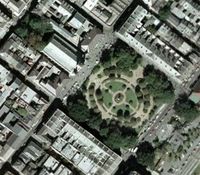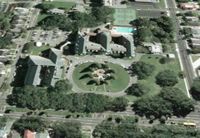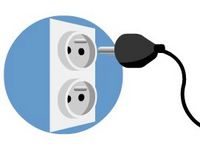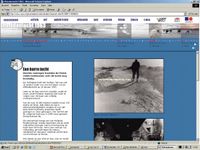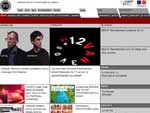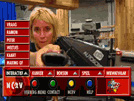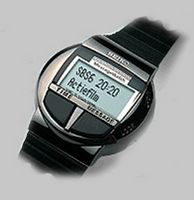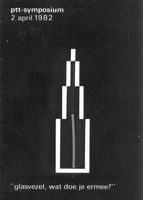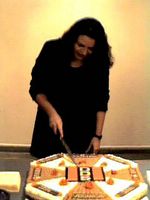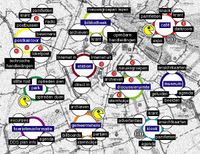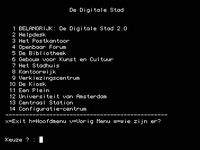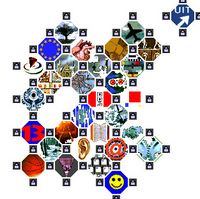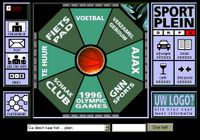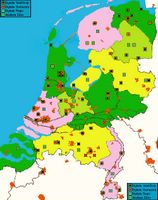Instalment 25: The Dutch online consumer after 25 years
This is the last instalment of the series on the History of Online in the Netherlands. As the last instalment it should be special. I had dreamed up several formats: the Virtual Hall/Wall of Fame in Online, a timeline, promises never fulfilled or a discussion on innovation. The Virtual Hall/Wall of Fame in Online was very interesting, but I decided that this was a task for a committee as too many arbitrary choices had to be made. A timeline was not really attractive as it would function more as an addendum than a last instalment. Of course Promises, Promises is a nice subject, but only with a proper analysis. And the discussion on innovation looked very attractive. Trying to unravel some of the unanswered questions like Why did Minitel in France succeed and Viditel in the Netherlands not; Why did videotext melt with the introduction of Internet as snow before the sun. And there are more questions like France was the first country on Minitel but almost the last one on Internet; Why is it that innovation usually ride on the back of a high economic wave. But all these ideas I put aside.in favour of taking a picture of the online consumer in the Netherlands in 2005.
It is now 2005. It is 25 years ago that the first public online service was launched. Can you imagine how many people had become acquainted with online in 1980. It is hard to say, but a rough guess would be that 500 people used the online service Viditel in that year and some 100 users of ASCII services (of the 12 million inhabitants). One year later in August 1981 there were 3.000 subscribers to the videotext service. Videotex had its haydays late 1994 and beginning 1995 with 350.000 online users; after 15 years of promotion. In 1995 there were 325.000 internet users online in the Netherlands; with very little promotion. Internet was a destructive technology for videotex. Looking back over the 25 years videotex appeared to be a ripple in the online pond orin 10 years internet became a commonplace.

 This graphs shows the growth of videotex between 1980 and 1997 as well as the stormy growth of internet from 1993 onwards in the Netherlands
This graphs shows the growth of videotex between 1980 and 1997 as well as the stormy growth of internet from 1993 onwards in the NetherlandsAlso the user profile has changed drastically from 1980 to 2005. The videotext services Viditel and Videotex Nederland did have more business clients than consumers. When in 1994 internet really started up in the Netherlands, it was only used by 1% of the 14 million people in population: young males, well educated and people living in the triangle area of Amsterdam, Rotterdam and Utrecht. In 2004 with 16,4 million inhabitants no less than 9,79 million people of 12 years and older have access at home to internet. The online population is now a representation of society, including women and seniors. The number of women using the internet is equal to men (in 1995 this was 80% men and 20% women). Also the geographical distribution of the internet users does almost represent the geographical distribution of the actual population.
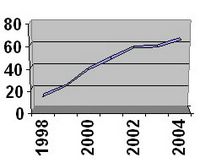 This is the curve from 1998 till 2004 of households having internet (Dutch stat office CBS)
This is the curve from 1998 till 2004 of households having internet (Dutch stat office CBS)
By now it is 52 per cent of the 6,4 million households which have broadband, meaning glass fibre, ADSL or cable. According to (belated) statistics of the EC, the Netherlands is now leader of the broadband pack.
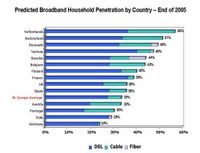 Predicted household penetration by country, where the Netherlands reached 56% of the households by the end of 2005 (source Strategy Analytics)
Predicted household penetration by country, where the Netherlands reached 56% of the households by the end of 2005 (source Strategy Analytics) In less than four years the dial-in facility ith modem will be replaced by always-on broadband (Dutch stat office CBS)
In less than four years the dial-in facility ith modem will be replaced by always-on broadband (Dutch stat office CBS)At present there is one computer available for every 8 students at schools. In 1995 it was 1 in 20 students, while only 5% of the teachers used a computer. Now 90% of the teachers use a computer for school activities.
More than 7,4 million people of 12 years and older use internet daily for e-mail, for surfing, downloading and electronic shopping. They surf on the internet to gather information on education and training, news, health, commercial products and services as well as job vacancies. Youngsters download games and music.
Electronic banking has also become popular. 1,9 million people banking with Rabo do it as well as 1,9 million people of ABN-AMRO and 1,6 million people of the Postbank. It is remarkable that the pioneer of electronic banking in the Netherlands, Postbank, is not leading the pact.
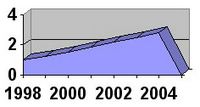
This graph shows the turn-over of internet shopping between 1998 and 2004 (in billions of euro)
Shopping on the internet shopping has grown from 1 billion euro in 1998 to 2,84 billion in 2004. It is growing steadily, but with an improving economy it should be more exuberant.
The list of internet-shopping goods and services runs like this:
- Travel, holidays and accommodations 37%
- Literature, books and magazines: 29%
- Video, DVDs and music: 24%
- Clothing and sports equipment: 24%
- Concert tickets: 21%
- Hardware and electronics: 17%
- Software: 12%
- Insurances: 9%
- Groceries: 4% 12%
- Other goods: 29%
Of the 6,5 million tax applications in 2005 no less than 5 million were transmitted digitally.
By the end of March 2005 there were 16,4 million mobile phones in the Netherlands.
Figures about set-top boxes for digital and interactive television are not known. But as there are many campaigns with free offers on the way with cable operators, a guestimate will be 1 million by the end of the year. This would include the 100.000 units of Digitenne, the digital terrestrial television network.
(The stats used in this blog come friom several sources such as the Cyber Atlas, the Dutch stats bureau CBS and press releases.)
This was the last instalment in this series on Online in the Netherlands. From tomorrow on there will again be a daily blog on various subjects. Please let me know whether you liked this series.


